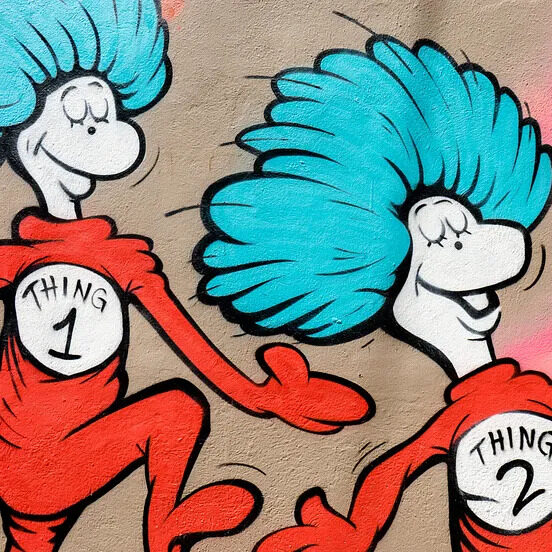Dr. Seuss, the beloved children’s author and illustrator, is celebrated for his distinctive aesthetic that combines whimsy, imagination, and surrealism. Surrealism, an art movement that emerged in the early 20th century, seeks to express the irrational and dreamlike aspects of the human mind. Dr. Seuss masterfully incorporates surrealistic elements into his illustrations, creating fantastical landscapes and characters that defy the constraints of reality.

Above is the cover of Dr. Seuss’s first published book: And to Think That I Saw It on Mulberry Street (9).
Influenced by surrealism, Dr. Seuss’s works often feature dreamlike scenarios and improbable creatures. The movement’s emphasis on the subconscious and fantastical imagery resonated with Seuss, who had a background in advertising and animation before venturing into children’s literature (2). His exposure to surrealism, as well as his work as a political cartoonist, infused his illustrations with a dynamic and imaginative quality (3).

Above are two of Seuss’s most famous characters, Thing 1 and Thing 2, featured in The Cat in the Hat (1). This image displays the surrealist style of Dr. Seuss.
The impact of Dr. Seuss’s aesthetic extends beyond the pages of his books. Renowned authors such as Maurice Sendak and Shel Silverstein drew inspiration from Dr. Seuss’s innovative use of language, playful rhymes, and vibrant illustrations (13). These elements, epitomized in classics like “Where the Wild Things Are” and “The Giving Tree,” showcase the enduring impact of Dr. Seuss’s unique style on the evolution of children’s literature.
Additionally, Seuss Landing, a themed area at Universal Studios Orlando, serves as a tangible manifestation of his whimsical worlds. Opened in 1999, Seuss Landing immerses visitors in a surreal landscape that mirrors the vibrant and playful aesthetic found in Dr. Seuss’s illustrations. The creative minds behind the design of Seuss Landing are the architects of KHS, who collaborated with Walter P. More Engineering, to bring Dr. Seuss’s vision to life (4). The enterance to Seuss Landing can be seen below (11).

Seuss’s avoidance of straight lines and preference for curved, whimsical shapes is a notable feature of his aesthetic (5). This distinctive approach is evident in Seuss Landing’s architecture, where buildings sway and lean, embracing the playful and unconventional style seen in Dr. Seuss’s illustrations. The use of bright colors, another hallmark of Seuss’s aesthetic, saturates Seuss Landing, creating an immersive experience that mirrors the lively and vivid worlds found in his books.



Above are three instances of Seuss’s unique yet iconic aesthetic from some of his most popular works: The Cat in the Hat (1), How the Grinch Stole Christmas (12), and Green Eggs and Ham (13).
Dr. Seuss’s influence is not confined to literature; it extends to various forms of media and art. Animated adaptations of his books celebrate and emulate his visual style, bringing his characters to life on screen (7). Additionally, contemporary artists and illustrators continue to draw inspiration from Dr. Seuss’s use of color, shape, and surrealism, incorporating these elements into their own work (8).

A scene from Dr. Seuss on the Loose, the animated television special, is pictured above (7).
In conclusion, Dr. Seuss’s aesthetic, characterized by surrealism, vibrant colors, and avoidance of straight lines, has left an indelible mark on children’s literature and beyond. Seuss Landing at Universal Studios Orlando stands as a testament to the enduring appeal of his whimsical worlds, thanks to the creative contributions of architects and designers. The influence of Dr. Seuss’s aesthetic persists in the realms of animation and art, ensuring that his imaginative legacy continues to captivate audiences of all ages.
Co Authors:
Chat GPT 3.5 – Open AI
Works Cited
- Dr. Seuss. “The Cat in the Hat.” Random House, 1957.
- Breton, André. “Manifestoes of Surrealism.” University of Michigan Press, 1972.
- Dr. Seuss. “Theodor Seuss Geisel: A Portrait of the Man Who Became Dr. Seuss.” Dr. Seuss Enterprises, L.P.
- “Seuss Landing.” Walter P Moore, 13 Nov. 2020, www.walterpmoore.com/projects/seuss-landing.
- Morgan, Judith, and Neil Morgan. “Dr. Seuss & Mr. Geisel.” Random House, 1996.
- Alexander, Tissa K. 22 January 2024.
- “Dr. Seuss on the Loose.” Directed by Hawley Pratt, MGM Television, 1973.
- “Contemporary Artists Inspired by Dr. Seuss.” My Modern Met, www.mymodernmet.com.
- Seuss, Dr. “And to Think That I Saw It on Mulberry Street”. HarperCollins Children’s, 2018.
- CityPedia. YouTube, 2022, https://www.youtube.com/watch?app=desktop&v=wTRf1rrb9_Q
- Seuss, Dr. How the Grinch Stole Christmas. Random House, 1985.
- Seuss, Dr. Green Eggs and Ham. Random House, 2001.
- Nel, Philip. Dr Seuss: American Icon. Continuum, 2005.


4 Comments. Leave new
Michael, first of all, well done on the thorough dive into Seussism! I enjoyed the content of your post and found it very informative. My only critique would be on the images. Instead of multiple book covers, it may be more beneficial to show the architecture of the worlds inside the books. I appreciate the creativity of this post and would not have thought of this aesthetic on my own.
Josh,
Thank you for your comment! As I was putting together this post, I also was unsatisfied by my use of book covers, and I wrongfully assumed that due to copyrights, I wouldn’t be able to use pages or images from within the books.
I have updated my post to include more examples of Seuss’s aesthetic inside his books.
Michael, I think this was a super interesting post with great word choice and content. I think you broke down and explained the aesthetic of Dr. Suess in a super effective manner. I would love to see more of how his influence was passed throughout children’s literature. Overall, I think this was a super effective and explanatory post, that does a great job explaining what creative elements went into the works of Dr. Suess.
Chris, thank you for your feedback! I really enjoyed learning about Seuss’s aesthetic and its impact as I put together this post.
Per your request, I have included a paragraph discussing specific examples of Seuss’s impact on children’s literature.